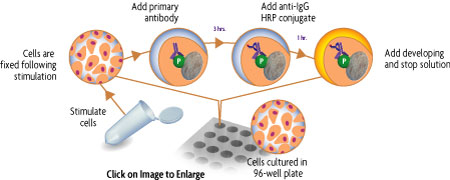THIS PRODUCT IS DISCONTINUED
Fast Activated Cell-based ELISA (FACE™) Kits provide a simple, sensitive method for detecting protein phosphorylation directly in the cell, without making extracts or performing electrophoresis and membrane blotting. These 96-well, high-throughput assays are available in both colorimetric and chemiluminescent formats for over 20 different targets (see list at right). For complete details, click the FACE™ Method tab below.
FACE Bad Kits provide 96 rxns each of 2 antibodies that enable you to monitor and compare the levels of both phosphorylated and total Bad. The phospho-Bad antibody recognizes Bad only when phosphorylated at Ser112; the total-Bad antibody recognizes Bad regardless of the phosphorylation state. Click the Bad Info tab below for data and more information.
| Name | Format | Cat No. | Price | |
|---|---|---|---|---|
| FACE™ Bad | 1 x 96 rxns | 48165 | Discontinued | |
| 5 x 96 rxns | 48665 | Discontinued | ||
| FACE™ Bad Chemi | 1 x 96 rxns | 48265 | Discontinued | |
| 5 x 96 rxns | 48765 | Discontinued | ||
| FACE™ Bad Manual |
| FACE™ Profile |
| Cell Biology Products Brochure |
| IsoCyte™ Application Note – Phospho-Protein Detection |
| MSDS: Sodium Azide |
| MSDS: Sulphuric Acid |
| MSDS: Thimersol |

Figure 1: Measurement of phosphorylated and total Bad.COS-7 cells were cultured in 96-well plates and serum-starved for 24 hours. Cells were then treated with 200 nM of PMA for 30 minutes and fixed. Total and phospho Bad were each assayed in triplicate using the phospho and total Bad antibodies included in the FACE Bad Kit. Data was plotted after correction for cell number (performed through use of Crystal Violet).
Antibody Specificities
The phospho-Bad antibody is specific for phosphorylated Bad and was raised against a synthetic phospho-peptide corresponding to residues surrounding Serine 112 of mouse Bad. This antibody recognizes Bad only when phosphorylated at this site and does not cross-react with other sites or related family members. The total-Bad antibody recognizes Bad proteins regardless of the phosphorylation state.
Bad Overview
Bad (Bcl-2 antagonist of cell death) is a proapoptotic member of the Bcl-2 family that displaces Bax from binding to Bcl-2 and Bcl-xL, which results in cell death. Bad forms heterodimers with other Bcl-2 family members and localizes to the outer mitochondrial membrane. When phosphorylated in the presence of survival signals, Bad translocates to the cytoplasm and blocks the induction of apoptosis. In the absence of survival signals, dephosphorylated Bad is localized in the outer membrane of the mitochondria where it activates mitochondrial-mediated apoptotic pathways. Thus, Bad is a unique Bcl-2 family member that plays a key role in the transduction of upstream survival signals to the Bcl-2 apoptosis decision machinery, and high-throughput study methods for monitoring Bad phosphorylation are in high demand.
The FACE™ Method
In FACE, cells are cultured in 96-well plates and stimulated to induce the pathway of interest. Following stimulation, the cells are fixed rapidly, which preserves activation-specific protein modifications. Each well is then incubated with a primary antibody specific for the activated protein of interest. Subsequent incubation with secondary HRP-conjugated antibody and developing solution provides a colorimetric or chemiluminescent readout that is quantitative and reproducible (Figure 1). The number of cells in each well can be normalized easily with the provided Crystal Violet solution. FACE Kits also contain primary antibody specific for the native inactive protein, so you can monitor both native and activated protein levels in the same experiment. FACE eliminates cellular extractions, radioactive kinase assays, time-consuming Westerns and inefficient epitope interactions that occur on membranes. FACE is a highly sensitive high-throughput assay designed for detecting activated proteins within mammalian cells.
Figure 1: Flow chart of the FACE process.
Flow chart of the FACE in cell Western method that uses a cell based ELISA to measure the levels of the native and phospho forms of signaling proteins and kinases that are activated by phosphorylation.
Contents & Storage
Two (or ten) 96-well plates for culturing cells, 96 (or 5 x 96) rxns each of two primary antibodies (1 phospho-specific, 1 specific for native protein), HRP-conjugated secondary antibody, Quenching Solution, 1X Antibody Blocking Buffer, 1X Antibody Dilution Buffer, 10X PBS, 10% Triton X-100, 1% SDS Solution, Developing and Stop Solutions, and Crystal Violet Cell Quantification Solution. Storage conditions vary from room temperature to -20°C, see manual for details. All reagents are guaranteed stable for 6 months when stored properly.


